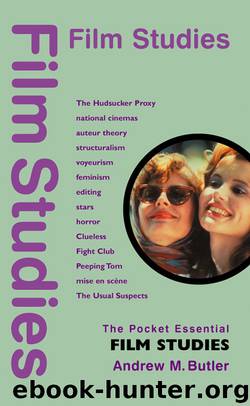Film Studies by Andrew Butler

Author:Andrew Butler
Language: eng
Format: epub
ISBN: 9781842438282
Publisher: Oldcastle Books
Published: 2012-01-12T16:00:00+00:00
The Canon
At the risk of sounding like a wimp, my selection of films has been somewhat pitiful from a feminist point of view: Seven (1995), Fight Club (1999), The Usual Suspects (1995) and Reservoir Dogs (1991). In Seven the only significant speaking rôle for a woman is Gwyneth Paltrow’s Tracey – a passive, caring victim appearing in a handful of scenes, with no life outside her home (aside from a visit to a diner). In Fight Club Marla is a character with some dubious morals who borders on the psychopathic. Keaton’s wife in The Usual Suspects is hardly a substantial part. And the only woman that I can recall in Reservoir Dogs is torn screaming from her car. Not a good start, really. There was Clueless, but perhaps that is tokenism.
The majority of directors and producers in Hollywood are male. This probably holds true in cinemas around the world. The movies that get the publicity budgets are made within male genres – blockbusters, war, science fiction or thrillers. These films seem to figure a central male character who is facing a male villain, and has a male best friend (who often gets killed by the villain in the penultimate reel, justifying the hero’s killing of the villain). The female characters are there to titillate, to be in distress and be rescued, and occasionally to guarantee the heterosexuality of the hero. (See chapter 8.)
This male dominance is true of almost all cultural productions – all have far more male creators than female. There’s some ideology at work in society that suggests that female narratives are too particular, domestic, or narrow to have wide appeal, whereas male narratives are universal, outgoing and broad. Even if a woman does manage to make a film, it is still difficult to break through and make a second or third. The canon of films embraced by audiences and critics remains predominantly male. The director discussed in this chapter, Patricia Rozema, has made it to four; an interest in passive or quiet women who start to fight for what they want appears to be emerging.
One explanation – not a justification – is that men go to the cinema to identify with the male hero and to ogle the female characters. The women in the audience, brought in tow by the men, are used to having to imagine themselves as male. This is a caricature of the version of cinema put forward and critiqued by Laura Mulvey in ‘Visual Pleasures And Narrative Cinema’. The end of narrative cinema – which Mulvey would probably like to see – would be a feminist move.
Download
This site does not store any files on its server. We only index and link to content provided by other sites. Please contact the content providers to delete copyright contents if any and email us, we'll remove relevant links or contents immediately.
| Coloring Books for Grown-Ups | Humor |
| Movies | Performing Arts |
| Pop Culture | Puzzles & Games |
| Radio | Sheet Music & Scores |
| Television | Trivia & Fun Facts |
The Kite Runner by Khaled Hosseini(5061)
Gerald's Game by Stephen King(4556)
Dialogue by Robert McKee(4305)
The Perils of Being Moderately Famous by Soha Ali Khan(4156)
The 101 Dalmatians by Dodie Smith(3440)
Story: Substance, Structure, Style and the Principles of Screenwriting by Robert McKee(3384)
The Pixar Touch by David A. Price(3344)
Confessions of a Video Vixen by Karrine Steffans(3230)
How Music Works by David Byrne(3157)
Fantastic Beasts: The Crimes of Grindelwald by J. K. Rowling(2975)
Harry Potter 4 - Harry Potter and The Goblet of Fire by J.K.Rowling(2974)
Slugfest by Reed Tucker(2923)
The Mental Game of Writing: How to Overcome Obstacles, Stay Creative and Productive, and Free Your Mind for Success by James Scott Bell(2835)
4 - Harry Potter and the Goblet of Fire by J.K. Rowling(2639)
Screenplay: The Foundations of Screenwriting by Syd Field(2561)
The Complete H. P. Lovecraft Reader by H.P. Lovecraft(2499)
Scandals of Classic Hollywood: Sex, Deviance, and Drama from the Golden Age of American Cinema by Anne Helen Petersen(2453)
Wildflower by Drew Barrymore(2431)
Robin by Dave Itzkoff(2368)
